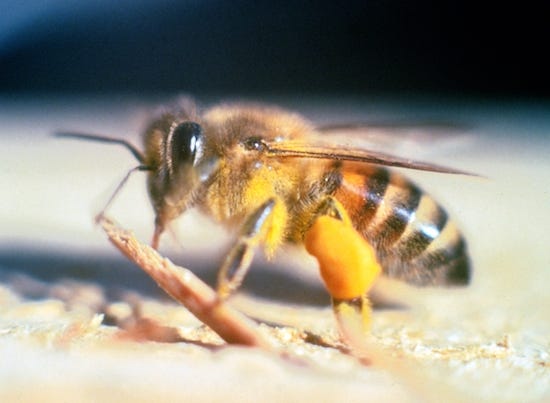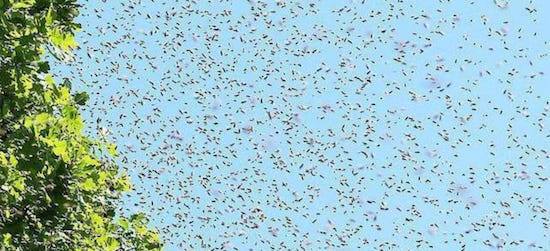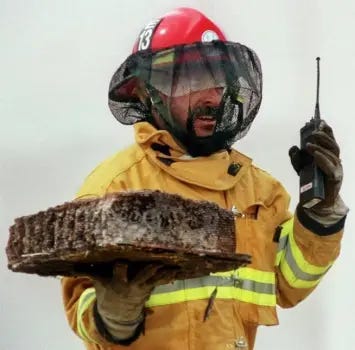To bee or not to bee, that is the question. Whether 'tis nobler for animal lovers to suffer the stings and arrows of killer bees or to take arms against a swarm of troubles and, by opposing, end them.
What arms? How do you kill killer bees? We’ll get to that. But first, holy shit, what a horrible way to die.
Texas Fatality
A Texas man was killed by a swarm of bees after disturbing a hive while mowing the lawn — despite a desperate escape attempt that saw him jump in his truck and crash into a neighbor’s front yard.
Stephen Daniel (above) frantically jumped into his vehicle to get away, but the bees followed him inside and continued to sting him until he crashed into Chrishae Cooper’s property.
Hang on nypost.com. I’ve watched enough Winnie the Pooh cartoons to know bees hives live way up high in hollow trees, not buried in the green green grass of home.
A bee hive positioned in a warm, dry, elevated nook helps protect the colony from intellectually-challenged fictional bears, actual bears, raccoons, skunks and wasps.
Correction: that’s the typical 10-40 of your nice, normal, everyday honey bee. Africanized bees build underground hives and murder any man or beast who fucks with it. Like… running it over with rotating steel-blades.
Actually, it’s worse than that. Texas Beekeeper Nan Helmke puts the sting in the tale.
Africanized bees will come after you if you get anywhere remotely near their hive; versus honey bees, you can walk right up to them.
Before you order your “This house protected by killer bees” sticker, know this: killer bees speak Portuguese.
The Boy From Brazil
Mr. Daniel’s friends and family can thank a South American beekeeper for the lawn mower man’s demise.
In 1952, a Brazilian named Dr. Warwick Kerr (above) decided he was the man to increase local honey bee productivity, hamstrung by Brazil’s tropical climate. A geneticist by day, Dr. Kerr had the motive, means and opportunity to create honey bee 2.0.
Dr. Kerr combined the East African lowland honey bee (Apis mellifera scutellata) with European honey bee subspecies, such as the Italian and Iberian honey bees.
Wrong Answer
Not only did his bastardized bees produce less honey than Western bees, they revealed themselves as flying psychopaths. More interested in protecting the colony than… anything.
They’re Heeeere!
Five years later, Dr. K was showing off his new bees to a newbie. A visiting beekeeper removed special screens designed to keep the hybrid queens and drones from escaping. Twenty-six swarms of Africanized honey bees escaped quarantine.
Dr. K’s “killer bees” migrated north, dominating indeed replacing native species.
Sometime in the early 90’s, killer bee colonies crossed our southern border. Taking up residence in Texas, Arizona, California, New Mexico, Nevada, Florida and Georgia.
Three decades later, the Centers For Disease Control and Prevention estimates that around 1000 Americans die from bee stings each year.
According to the CDC, killer bees account for a “notable portion" of these deaths. Not to mention hundreds of thousands of killer bee-related injuries and the resulting psychological trauma.
Killer bees are also no friend to American livestock. The same month Africanized bees sent Mr. Daniels to his reward, nbcdfw.com reported that North Texas couple loses three horses to aggressive bee attack.
Media Matters
While nbcdfw.com attributed the equine elimination to killer bees, The New York Post, USA Today and other media outlets somehow failed to mention the Africanized nature of Mr. Daniels’ killers.
Nor do kold.com’s journalists identify the bewinged aggressors terrorizing teens in their story More than 20 people stung in bee attack at southern Arizona school.
KOLD’s go-to bee attack expert — Reed “The Killer Bee Guy” Booth (above) – was curiously incurious about the bee species responsible.
They’ve killed three people in this county this summer, that we know of, just in Cochise County.
They are sending people to the hospital every day in this county. It used to be five or six a year, and now they are super aggressive and we don’t know why.
Coverup?
Why are Africanized killer bees flying under the media radar while shark attacks are constant clickbait?
Maybe the term “Africanized” is PC poison. Maybe being stung to death by killer bees is less interesting than being eaten by a shark (thank you Steven Spielberg).
The relative lack of killer bee coverage could have something to do with the fact that shark attacks often have happy-ish endings. Killer bee victims, not so much.
Killer Bee Defense
So what’s a mother to do?
“If you see someone being attacked by bees, encourage them to run away or seek shelter,” the University of Arizona advises. “Do not attempt to rescue them your self, seek emergency help.”
Like they need “encouragement” to run? Like emergency responders can fight off a killer bee swarm?
Yes they can! Here’s the recommended protocol via lubbock.tamu.edu:
Using standard fire fighting procedures, set up a line with an educator capable of delivering a one to three percent spray of one of the foaming/wetting agents and a nozzle capable of delivering a wide fan pattern.
A light initial application to the victim will stop the attack by most of the insects on or near the victim within 60 seconds. These insects, unable to fly, will begin to suffocate and can be quickly brushed aside.
If an obvious line of insect flight can be determined, a vertical wall of spray 20 to 30 feet in the air should intercept further flight activity. Or, the nozzle can be inverted near the victim to provide a curtain of safety.
Rescuers wearing proper protective gear then can carry a victim into a house, van or ambulance for treatment and transport.
Many bees, however, will follow to continue their attack. In a house, vacuum up bees attracted to windows by light. In a rescue vehicle, drive away and then roll down the windows and chase the insects out.
Which is all well and good if you don’t die before bee-attack-trained firefighters make the scene. A killer bee swarm can deliver enough venom to kill a human in under two minutes. Do the math.
Bee Careful!
In case you missed it, killer bees are ruthless killers. Remorseless? D’uh. As Poet William Blake opined, “the busy bee has no time for sorrow.” You’ve been warned.










This is why I never travel south without a honey badger.
So these killer bees are all seriously inbred? Or is that common in the insect world?